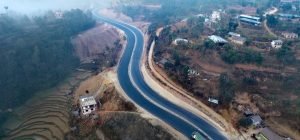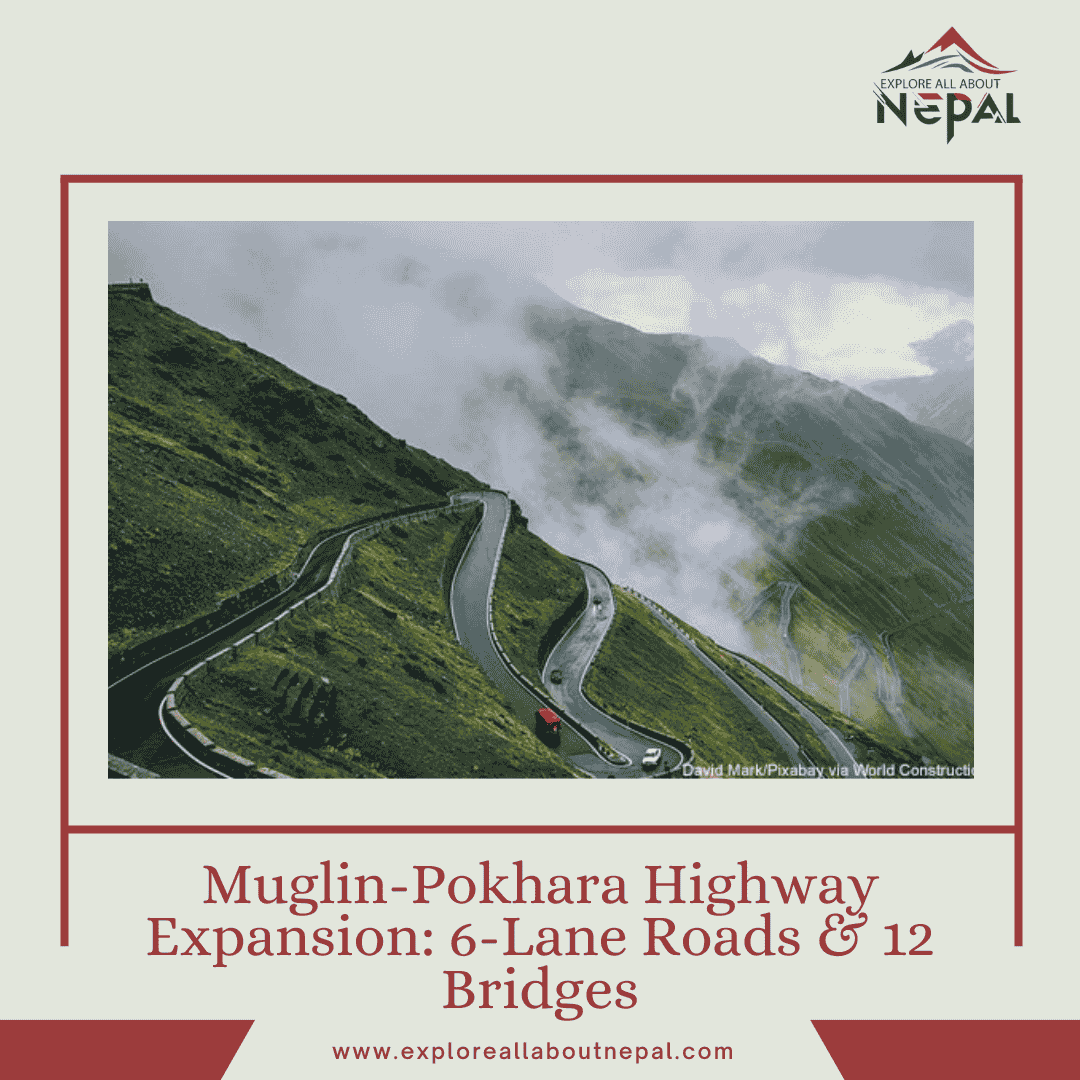Muglin-Pokhara Highway is a vital road connecting Nepal’s capital, Kathmandu, to the picturesque Pokhara Valley. As one of the busiest roads in Nepal, the highway has long been a key infrastructure component in facilitating both domestic and international travel.
With the increasing demand for safer and more efficient transportation, the government of Nepal, in collaboration with international investors, has been working tirelessly to upgrade and expand this critical highway. The Muglin-Pokhara Highway expansion promises smoother travel with the introduction of 6-lane roads, 12 bridges, and over 80% completion. This expansion will have a significant impact on the entire region, enhancing connectivity, boosting tourism, and stimulating local economies.

Overview of the Muglin-Pokhara Highway Expansion Project
The expansion of the Muglin-Pokhara Highway is a significant undertaking that involves upgrading the road to a modern and multi-lane highway. The project is aimed at improving traffic flow, reducing travel time, and enhancing road safety. This will not only benefit the thousands of commuters who travel daily between these two key cities but will also provide a smoother route for goods transportation, boosting economic activities in the region.
The project is being carried out in two major sections:
Eastern Section (Anbukhaireni to Jamune):
This 41-kilometer section of the highway has made substantial progress, achieving 81% physical completion. The construction has included upgrading the existing road and building several bridges to improve connectivity. In addition, this section has already completed the construction of all 17 planned bridges. While there are only 5 kilometers left to be blacktopped in areas such as Damauli Bazaar, Bimalnagar, and Nahala Bridge, work is ongoing, and the project is expected to be finished soon. Once completed, this section will significantly improve road conditions and safety for travelers.Western Section (Jamune to Pokhara):
The 39-kilometer stretch from Jamune to Pokhara has also seen remarkable progress, with 43.34% of the work completed so far. Approximately 29.47 kilometers of this section have been blacktopped, making the road easier and safer to drive on. Out of the 12 planned bridges, nine are nearing completion. This section of the highway is crucial for ensuring uninterrupted connectivity between the bustling city of Pokhara and the rest of Nepal.
Key Features of the Highway Expansion
The Muglin-Pokhara Highway expansion is designed to accommodate the growing traffic demand while ensuring safety and ease of travel. Here are some key features of the expansion:
Six-Lane Roads:
One of the most significant changes in the highway expansion is the introduction of six-lane roads, particularly in densely populated areas such as Damauli and Dumre Bazaar. This will allow smoother traffic flow, reduce congestion, and ensure better safety for both passengers and pedestrians.Construction of Bridges:
The expansion involves the construction of 12 major bridges and 31 minor bridges. These bridges will help eliminate bottlenecks, especially in hilly regions where rivers and valleys often make road construction challenging. The inclusion of new bridges will improve connectivity and reduce travel time, especially during the monsoon season when certain sections of the road are prone to landslides and flooding.Blacktopping and Road Widening:
The road will be widened and blacktopped, making it more durable and capable of supporting heavier traffic. This will make the highway much more accessible and reliable for both domestic and international travelers.
Challenges Faced During Construction
Like any major infrastructure project, the Muglin-Pokhara Highway expansion has faced several challenges that have slowed down its progress:
COVID-19 Pandemic:
The global health crisis had a significant impact on the construction timeline. The pandemic disrupted construction activities, delayed the import of materials, and limited the availability of laborers. This led to delays in the completion of various sections of the road.Environmental Concerns:
A significant challenge in the construction process has been the environmental impact, particularly the need to cut down around 6,750 trees in the Tanahun section of the highway. Environmental activists and local communities have raised concerns about the loss of green cover and its effects on the ecosystem. However, efforts have been made to minimize the impact, and replantation initiatives have been undertaken.Infrastructure Relocation:
A considerable amount of time was spent relocating water supply pipelines, electricity lines, and roadside structures. This process was necessary to make space for the new highway, but it caused significant delays, particularly in the Damauli and Dumre areas.
Economic and Social Impact of the Highway Expansion
The Muglin-Pokhara Highway expansion is expected to have far-reaching effects on the local and national economy. Here are some of the key benefits that the highway expansion will bring:
Boost to Tourism:
Pokhara is one of the most popular tourist destinations in Nepal, attracting both domestic and international visitors. The highway expansion will make it easier for tourists to travel to Pokhara, which will likely result in an increase in the number of visitors. Easier access to Pokhara’s natural wonders, such as Phewa Lake, Sarangkot, and the Annapurna Mountain Range, will boost tourism-related businesses and services.Enhanced Connectivity and Reduced Travel Time:
The expansion will significantly reduce travel time between Kathmandu and Pokhara, making it easier for people to travel between the two cities for business, tourism, and other purposes. This improvement in connectivity will enhance social interaction, trade, and overall accessibility for communities living along the highway.Improved Safety and Reduced Accidents:
With the widening of the road and the construction of better bridges, the risk of road accidents will be reduced. The improved infrastructure will make the highway safer for travelers, including freight trucks, passenger vehicles, and pedestrians.Economic Growth and Job Creation:
The project has already created jobs for thousands of people during its construction phase, and it will continue to create long-term employment opportunities once the road is completed. Additionally, the improved highway will facilitate smoother transportation of goods, which will benefit local industries and businesses.
The Role of International Investment and Funding
The Muglin-Pokhara Highway expansion is a major investment project, financed with a combination of local and international funds. The Asian Development Bank (ADB) has provided a loan of $195 million for the project, with an additional $59 million being contributed by the Nepalese government. The project is being executed by Chinese companies, including China Communication Construction Company (CCCC) for the eastern section and Anhui Kaiyuan Highway and Bridge Construction Company for the western section.
Highlights
Conclusion
The Muglin-Pokhara Highway expansion is a game-changer for transportation in Nepal. With six-lane roads, 12 major bridges, and the promise of a much smoother travel experience, the project is set to enhance connectivity, boost tourism, and contribute significantly to the region’s economic growth. While there have been challenges along the way, such as the COVID-19 pandemic and environmental concerns, the project’s completion will undoubtedly bring substantial benefits to Nepal’s infrastructure. As the highway nears its completion, travelers can look forward to faster, safer, and more comfortable journeys between Kathmandu and Pokhara.
The expansion of the Muglin-Pokhara Highway is a milestone in Nepal’s infrastructure development and a crucial step toward modernizing the country’s transportation network.


